Minister’s Annual Report on Lake Simcoe, 2017
Read a summary of actions taken during 2017 to protect and restore Lake Simcoe, as well as advice from two advisory committees.
Minister’s Message
Clean, reliable sources of water lead to a better quality of life and are central to healthy, vibrant communities. In Ontario we have an abundance of water with more than 250,000 lakes and rivers. Many are sources of drinking water, protected by strong legislation. Some are sources of food and others offer tremendous economic benefits through tourism and recreation.
As a government, our goal is to protect and preserve water resources so that people and communities can continue to thrive. We have released a made-in-Ontario environment plan to help protect our air, land and water, address litter and reduce waste, support Ontarians to continue to do their share to reduce greenhouse gas emissions, and help communities and families prepare for climate change.
The 2017 Lake Simcoe Annual Report details how our government, with the people of Ontario, are taking action to protect and restore the largest inland lake in southern Ontario aside from the Great Lakes, and ensure it can continue to sustain one of Ontario’s fastest growing regions.
Collaboration between organizations, community groups, local advocates, levels of government and the Lake Simcoe Region Conservation Authority are having a positive impact on the health of the lake. Despite pressures such as urban growth and climate change, key indicators, including fish populations are showing some positive signs – indicating that water quality is improving. The work that partners are engaged in, such as the adoption of green building practices and investments in new sewage treatment technology, demonstrates that participation and smart investments in communities within the watershed can have lasting benefits for our environment.
Our efforts to protect Lake Simcoe are paying off but this is not a signal to end our commitment. We are monitoring and responding to ongoing and emerging threats to water quality like road salt, microplastics and other contaminants, and extreme weather events. We are also working with local stakeholders to implement programs to detect and prevent the spread of invasive species, and collaborating with municipalities and Indigenous communities to implement adaptation plans that will ensure we are building communities that are resilient to the effects of climate change.
In the coming year, public input will play an important role in the legislated review of the Lake Simcoe Protection Plan. People living within the watershed and all who have an interest in the health of the lake will be encouraged to have their say in how we move forward with Ontario’s premier watershed based protection plan.
I invite you to read about some of the exciting projects that are taking place. The good news stories and examples of ongoing work among community, business, and government partners may compel you to get involved in helping to protect and restore the watershed you live in.
Sincerely,
The Honourable Rod Phillips
Minister of the Environment, Conservation and Parks
Introduction
The Lake Simcoe watershed is 3,307 square kilometres in size, with 2,502 square kilometres in total land area. The lake has played an important role in provincial history. For hundreds of years, it served as a transportation link for Ontario’s First Nations and Métis communities, fur traders and the logging industry.
Containing diverse natural, urban and agricultural systems, including parts of the Oak Ridges Moraine and the Greenbelt, the Lake Simcoe watershed continues to serve as a natural connector between communities. The residents, wildlife and plants rely on its provincially significant wetlands, woodlands, recreational areas and some of the most productive agricultural land in Ontario, including the Holland Marsh. These lands generate over $450 million annually with an estimated total economic impact of over $1 billion each year between the farm-gate value of the vegetables, packaging, processing, and transportation.

Shoreline of Jackson’s Point on Lake Simcoe
Lake Simcoe is a complex ecosystem that is home to many different fish species, as well as many other aquatic plants and animals. Six water treatment plants draw water from the lake providing purified, clean drinking water for local communities. The lake and tributaries are receiving water for fifteen sewage treatment plants.
Known as the “ice fishing capital of Canada”, the Lake Simcoe watershed also supports a thriving tourism industry and provides highly valued year-round diverse recreational opportunities. It is the most intensively fished inland lake in the province. Recreation activities, like boating and hiking, also help make Lake Simcoe a popular summer vacation area, it is estimated the population of the watershed grows by approximately 50,000 cottagers during the summer months.
The Lake Simcoe Protection Act is a comprehensive framework and the key instrument guiding efforts to protect and restore Lake Simcoe.
The Lake Simcoe Protection Plan (the Plan), established in 2009, was the first plan in Ontario to identify threats at a watershed scale and propose actions to address them.
The vision for Lake Simcoe includes:
- a healthy environment where communities can enjoy all of the recreational and economic benefits of living within the watershed
- a healthy ecosystem for the many native species of fish, wildlife and plants that make Lake Simcoe a treasured resource
- natural shorelines where development is well-planned and sustainable for future generations
- greater cooperation and leadership among all partners who work to protect the lake.
The approach taken to support the implementation of this vision is multi-faceted. A suite of management measures are being implemented to reflect challenges facing the watershed. Pressures are wide-ranging, including excessive nutrients, pollutants, invasive species, impacts of climate change and urban development. These pressures are expected to continue as the population increases. The current programs are adaptable to changing conditions in the watershed and new information, to ensure we take the best action to manage threats.
The Province maintains a strong partnership between three lead ministries – Environment, Conservation and Parks, Natural Resources and Forestry, and Agriculture, Food and Rural Affairs. The Ministry of the Environment, Conservation and Parks is the lead for the Plan implementation and supports work to inform the adaptive management approach, and work under the Plan related to conservation, protection, management of water resources (e.g. quality and quantity), as well as climate change mitigation and adaptation. The Ministry of Natural Resources and Forestry leads work under the Plan related to fisheries management, natural heritage and important ecological areas (e.g. shorelines, high quality natural heritage areas), invasive species and biodiversity. Work related to the preservation and enhancement of agricultural lands, nutrient-management planning and soil conservation, and local agricultural production in the watershed is led by the Ministry of Agriculture, Food and Rural Affairs. The Plan is also supported by two Minister’s advisory committees made up of key stakeholders in the watershed, one focusing on research and monitoring, and one supporting the plan’s implementation.
Many other groups and individuals work together with the Province to protect and restore the Lake Simcoe watershed using the Lake Simcoe Protection Plan as a framework to bring their projects together and build upon successes. The successful implementation of the Plan relies on this support. Key partners include the Lake Simcoe watershed municipalities, First Nations and Métis communities, the Lake Simcoe Region Conservation Authority, universities, and the people who live, work and vacation in the watershed.
This report highlights the collaborative work undertaken in 2017 by the Province and partners to carry out the long-term vision for the lake. Many of the initiatives described in the report could be seen as an ‘incubator’ for new and innovative ideas, approaches and actions. In the Lake Simcoe watershed, we are developing and piloting solutions that benefit not just this area, but all of Ontario and beyond.
As a result of the work completed to date in implementing the Plan, there is good news that watershed residents and visitors can celebrate. The long-term phosphorus levels have dropped in many of the rivers and streams feeding into the lake, and some native fish species are showing some signs of potential recovery. While there are signs of improvements, work remains to be done to protect and restore the watershed.
Water quality
Clean water is critical to both human health and well-being. One of the greatest impacts on the water quality of Lake Simcoe is caused by excess phosphorus entering the lake through runoff from urban, agricultural and natural areas. Phosphorus promotes the growth of plants and algae in the lake. When aquatic plants and algae are abundant, their decomposition creates an oxygen shortage at the bottom of the lake. This shortage impairs coldwater fish habitat. During the 1980s and 1990s, the lack of oxygen in Lake Simcoe was so severe that young coldwater fish were unable to survive.
There have been encouraging signs of recovery in the Lake Simcoe ecosystem, indicating that on-going remedial efforts continue to be effective. Figure 1 shows that the total phosphorus concentrations have decreased in the open waters of the lake during the spring since the 1980s. Figure Two shows that deep water dissolved oxygen has increased over the long term. The target in the Plan of a deep water dissolved oxygen level of 7 milligrams per litre to restore a self-sustaining coldwater fish community in Lake Simcoe is indicated by the dotted line as illustrated in Figure 2. To ensure a healthy ecosystem, more work is needed to raise oxygen levels so the fish community can sustain itself. For this reason, we remain committed to encouraging the use of innovative approaches, infrastructure upgrades and policy tools to reduce phosphorus loads and levels.
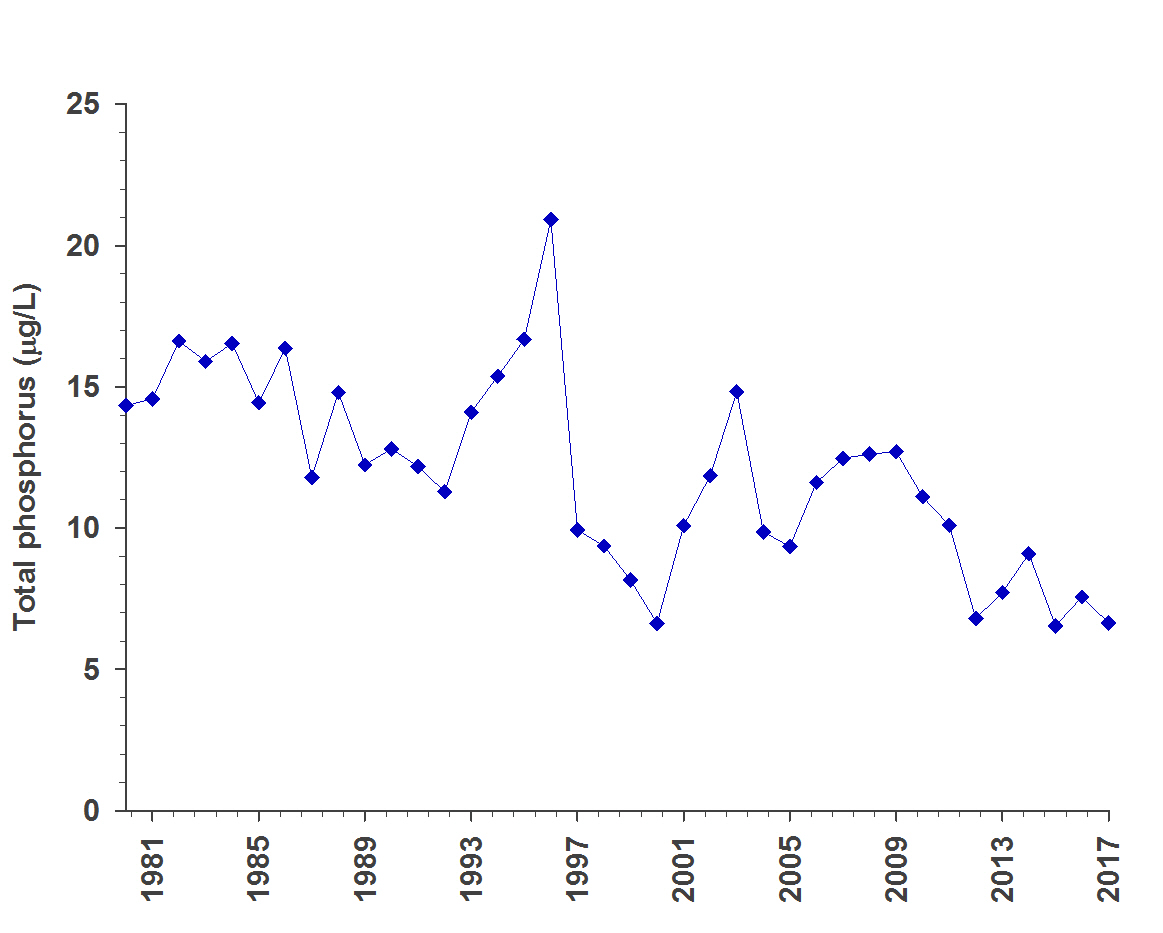
Figure 1: Changes in spring total phosphorus average concentrations from multiple sampling events in Lake Simcoe (1980 to 2017)
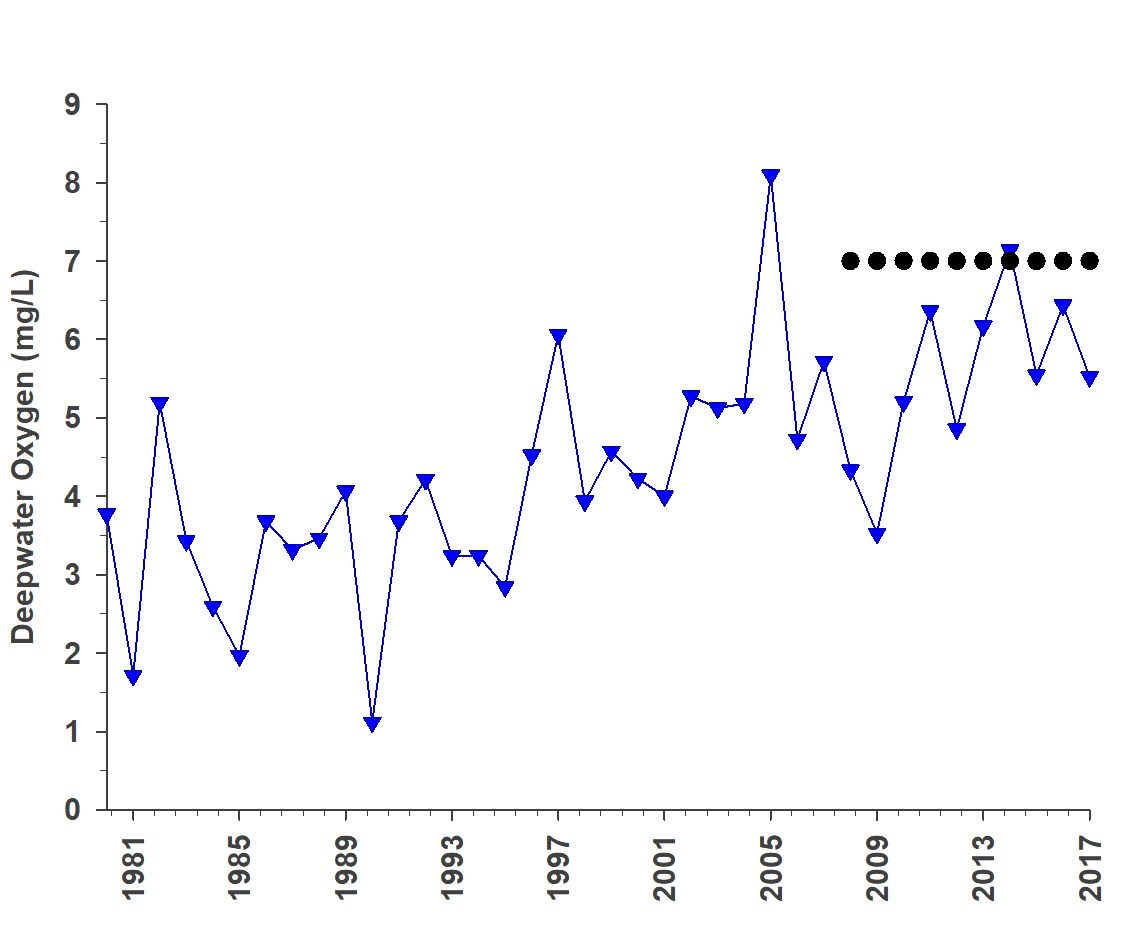
Figure 2: Changes in deepwater oxygen in Lake Simcoe (1980 to 2017) with the plan target of 7 milligrams per litre indicated by the dotted line
Sewage Treatment Plants
Before the Plan came into effect, sewage treatment plants were contributing approximately seven per cent of the total phosphorus loads to the lake, an average of 5.1 tonnes/year. Upgrades in treatment technology have resulted in a significant decline in the phosphorus loads that come from the sewage treatment plants. In 2017, the total amount of phosphorus going into the lake from sewage treatment plants now represents 3 per cent of all total phosphorus loads to the lake, less than two tonnes/year.
These reductions are a direct result of the significant investments municipalities have made to upgrade treatment technology. Plants in the Lake Simcoe watershed are now among the best in Ontario at phosphorus removal. The processes implemented at these facilities can be used as an example to other areas of the province that are experiencing water quality impacts related to high phosphorus loadings.
Remote Sensing
Non-point sources of nutrients, such as land runoff, atmospheric deposition, and seepage are often very difficult to identify and estimate. However, they can have great impacts on receiving waters, especially in areas with significant agricultural production or human activity.
Current understanding of how much phosphorus is present in the environment has relied on traditional monitoring methods, where a soil or water sample is collected from the watershed and analyzed in a laboratory. Remote sensing (monitoring from a distance) is a unique way of assessing the Lake Simcoe watershed. The St. Lawrence River Institute recently completed research to see if it is possible to estimate non-point sources (land runoff and atmospheric deposits such as dew and frost) of phosphorus over large geographic areas using data collected from remote sensing.
The project combined satellite imagery, with results from soil samples to build a soil phosphorus concentration model. The model was found to be generally accurate with estimated soil phosphorus concentrations across the Pefferlaw/Uxbridge Brook and Beaver River subwatersheds.
The project found that there is a significant correlation between average upstream soil phosphorus estimates and observed total phosphorus in the water. With further refinement, the soil phosphorus concentration model may serve as a strong predictor of phosphorus loading within the Lake Simcoe watershed. Project details can be accessed here.
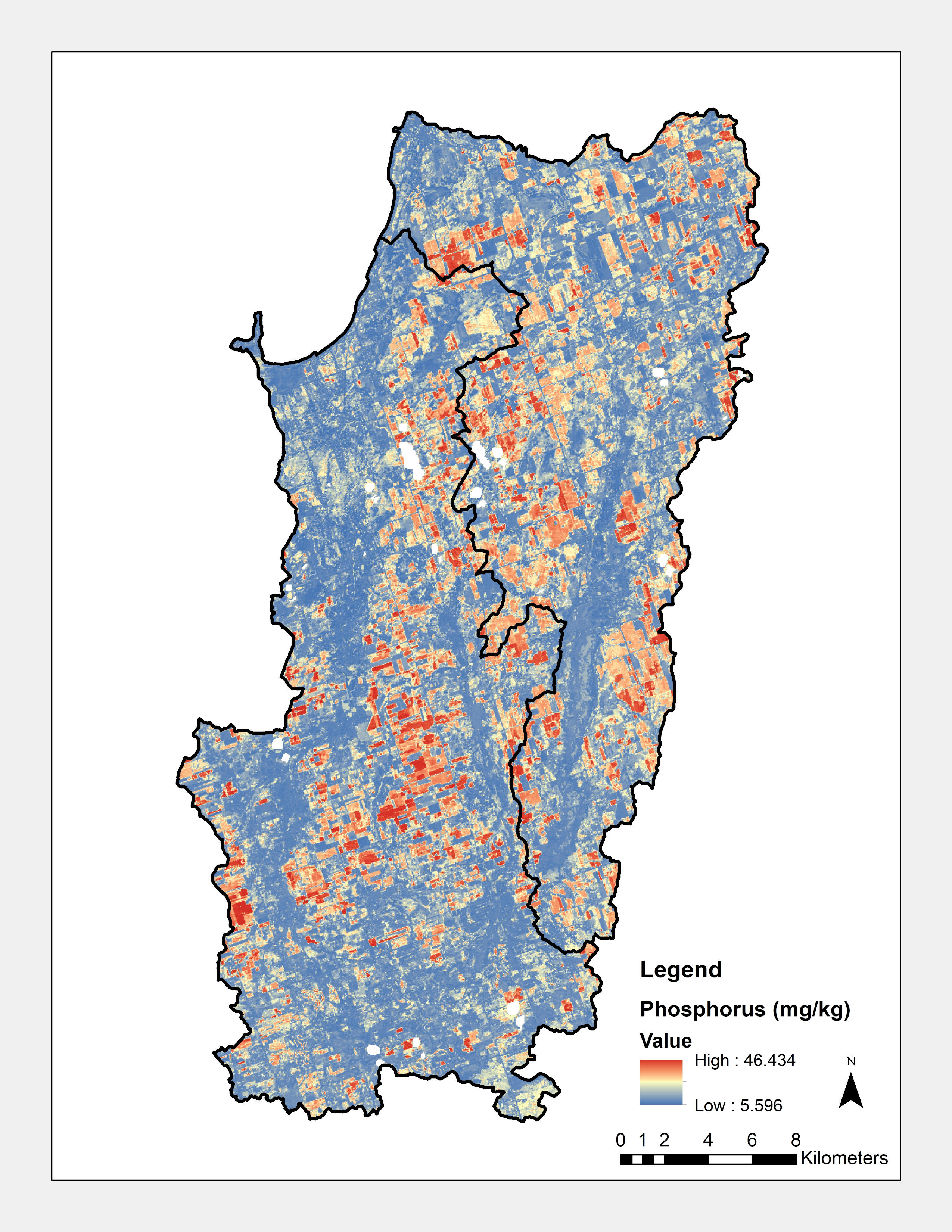
Figure 3: Map of soil phosphorus estimates through the Pefferlaw/Uxbridge and Beaver subwatersheds generated using the soil phosphorus concentration model.
Low Impact Development (LID)
Low Impact Development is a stormwater management strategy that aims to mitigate the impacts of stormwater pollution and increased stormwater flow by managing runoff as close to its source as possible. It does this by using site design features that mimic natural processes in built structures by collecting water for reuse, releasing it slowly to nearby watercourses or allowing it to infiltrate into the ground. Low Impact Development features can effectively remove nutrients and pollutants from runoff, and they help to reduce the volume and intensity of stormwater flows.
The Low Impact Development Treatment Train Tool was developed by the Sustainable Technologies Evaluation Program, to help developers, consultants, municipalities and landowners understand and implement more sustainable stormwater management planning and design practices. This tool provides a quick and consistent approach to estimating site level phosphorus loads and developing water budgets and will help developers determine the most appropriate Low Impact Development features to install. This open-source tool can be downloaded by practitioners via the Sustainable Technologies Evaluation Program website for use at any site in the province that is adopting Low Impact Development strategies.
Phosphorus Offsetting
In January 2018, the Lake Simcoe Region Conservation Authority implemented the Lake Simcoe Phosphorus Offsetting Policy to improve water quality. Also referred to as a zero export policy, development projects must control all of the phosphorus leaving the site. If zero discharge is not achievable, the phosphorus output has to be offset at a location within the same subwatershed, at a ratio of 2.5 to 1. This means that for every tonne of phosphorus that enters the environment from the site, 2.5 tonnes of phosphorus will be removed from elsewhere in the subwatershed. The Lake Simcoe Phosphorus Offsetting Policy will use tools such as Low Impact Development practices to manage phosphorus discharges, create opportunities to invest in stormwater retrofits, and encourage innovation in the design of development projects.
Innovative Technologies
Ontario’s leadership in tackling excess phosphorus has been centre stage over the past year as competitors for the international George Barley Water Prize made the Holland Marsh their testing ground. Teams from around the world have been competing over the past two years to find a safe, cost-effective way to remove excess phosphorus from freshwater supplies. Nine teams, including two teams from Ontario, advanced to this stage of the competition. The winner will receive a $10 million USD grand prize named after the late conservation advocate and Everglades Foundation co-founder – George Barley.
Managing Road Salt
Winter salt is one of many tools people use to manage snow and ice. Concerns about perceived liability often results in using salt when it is not necessary or effective. People may not be aware that ice melters and de-icers can have damaging impacts to buildings, landscapes and drinking water. We urge residents to do their part to make a shift away from over-using salt on snow and ice in an effort to protect our water and their homes. Data shows that chloride concentrations are increasing in Lake Simcoe and its tributaries. Figure 4 shows that since 1980, chloride concentrations have significantly increased at eight monitoring stations on Lake Simcoe.
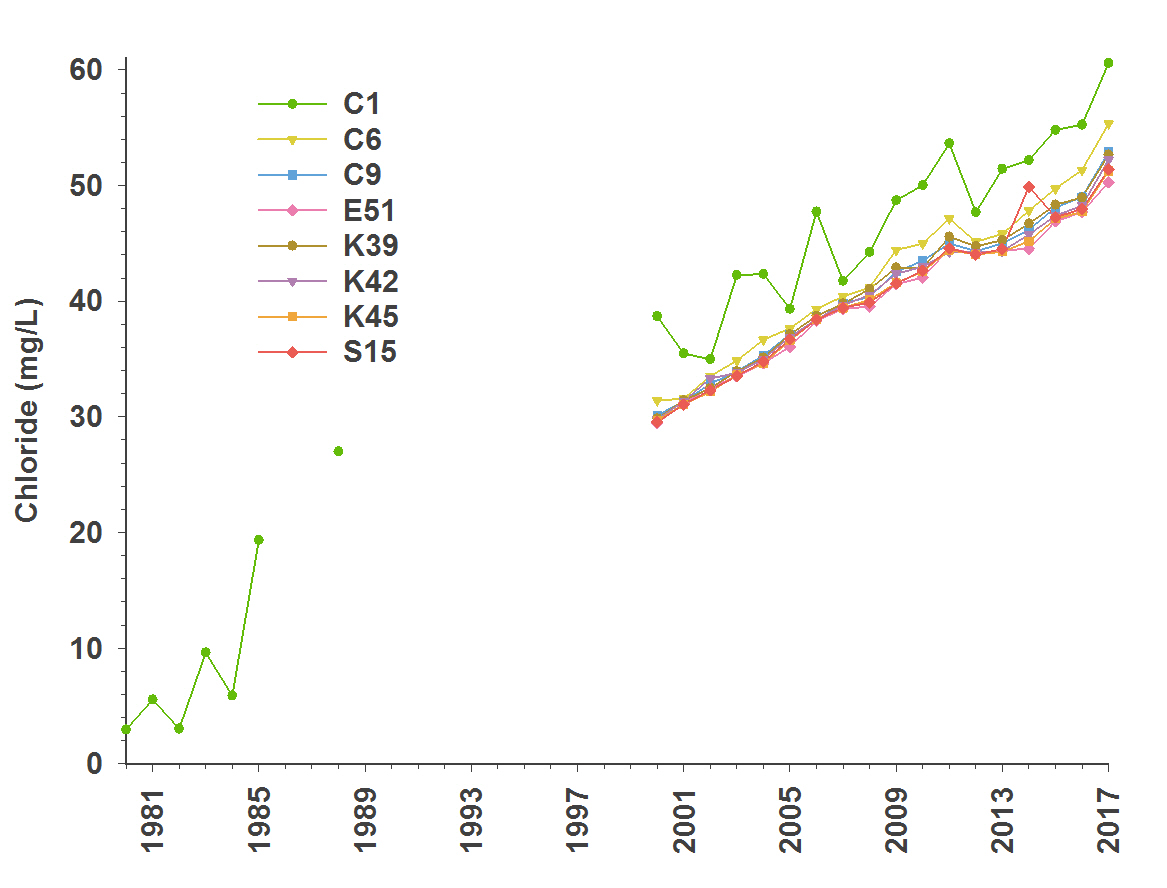
Figure 4: Changes in average chloride concentrations at eight lake stations around Lake Simcoe 1980 to 2017.
Municipalities are doing their part to keep salt and sand out of waterways by adopting leading practices to keep sidewalks and roads safe. The City of Barrie’s Salt Optimization Strategy was adopted, to minimize environmental impact while maintaining safe surfaces, during this reporting period. Barrie also publicly reported a 43 per cent reduction in salt use, saving tax payers $480,000 over the past ten years. The Town of East Gwillimbury converted some of their routes to alternative de-icer materials reducing the amount of effort and materials required to manage snow and ice on their roads. The Towns of Aurora and East Gwillimbury each switched from high rate salt sand mixtures and have achieved significant costs savings associated with removing winter sand from roads and stormwater infrastructure.
During the winter of 2017, the Lake Simcoe Region Conservation Authority completed paved surface friction testing in an effort to answer people’s questions about traction on walking and driving surfaces. The key finding from this work shows that over-application of road salt on walkways can actually reduce friction (making the surface less grippy) as the excess rock salt is a slip hazard. The best friction is achieved when the applied salt has melted the snow or ice and there is no residual rock salt left.
The Ministry of the Environment, Conservation and Parks along with the Lake Simcoe Region Conservation Authority have been working on a number of projects to manage the impacts of road salt, including co-hosting a binational forum with World Wildlife Fund-Canada and the United States Consulate in the fall of 2017. This forum was an important step to raising awareness of rising chloride levels across Ontario, and engaging owners of large parking lots and their contractors in adopting best practices for maintaining traction by using just enough road salt.
Piloting New Technology to Monitor Pharmaceuticals and Personal Care Products
The Ministry and partners are piloting the use of new sampling technology to support long-term water quality monitoring and research about emerging contaminants, including pesticides, pharmaceuticals and personal care products. This new technology is referred to as integrated passive sampling. Samplers are placed in the water for days or weeks at a time to allow contaminants that may be present in the water to be taken up into the material contained in the devices.
In the pictures below, Figure 5 depicts the Polar Organic Chemical Integrative Samplers (or POCIS for short) contained in a sampling cage ready for deployment in the East Holland River. Figure 6 shows the POCIS samplers after removal. The samplers were submerged in water for 2-3 weeks in each of June and October 2017. Results of the sampling will be discussed in the next Lake Simcoe Five Year Monitoring Report.
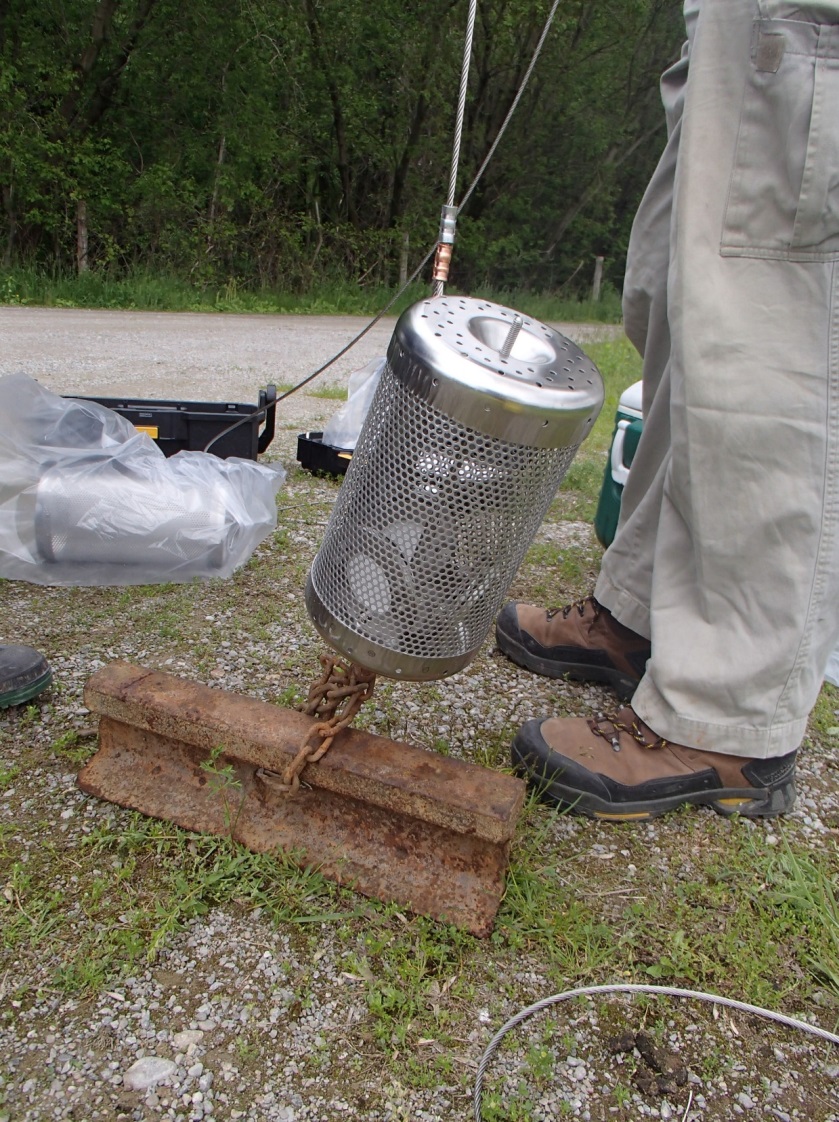
Figure 5: Polar organic chemical integrative sampler prior to deployment in the East Holland River
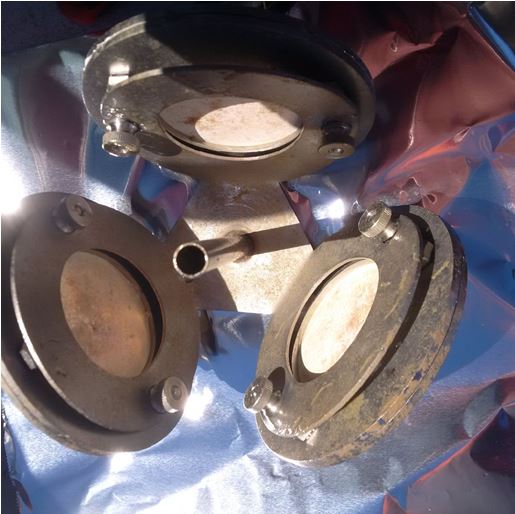
Figure 6: Polar organic chemical integrative sampler after removal from the East Holland River.
Groundwater Study
Pollutants can be transported to a waterbody through multiple sources, but how groundwater carries pollutants into lakes is not well understood. The Ministry of the Environment, Conservation and Parks and the University of Western Ontario are studying the location and timing variability of groundwater discharge into Lake Simcoe and the Great Lakes, and the effects those discharges have on our surface water quality. Groundwater discharge into lakes can be either direct, or indirect through groundwater fed streams. Although considerable work has been done to understand the major groundwater recharge and discharge function in Southern Ontario, there remain key science gaps regarding the influence groundwater discharges have on surface water quality.
This is a concern as land use and resource development decisions may be made without an adequate understanding of the way in which groundwater and surface water interact and affect ecosystem health. Although groundwater inputs are generally a small component of the water budget (by volume), pollutant concentrations can be much more concentrated in groundwater. This is particularly important in areas where there are shallow aquifers adjacent to a shoreline, as the water quality in these aquifers can be affected by surrounding land uses such as shoreline development and agriculture.
Western Engineering has been using a variety of field techniques to identify and map key areas where groundwater flows into the lake. They found evidence to suggest that E.coli (Escherichia coli) in beach sand can be transferred by wave action to surface water and affect water quality. This research is helping to improve our understanding of how groundwater and surface water interact. It will be used when making decisions to manage non-point pollution sources; for example, it may help us better understand the causes of beach postings.
Erosion and Sediment Control
Soil erosion is a relatively slow, naturally occurring process that is significantly influenced by what is happening on the landscape. When soil is disturbed and exposed to the elements, it has the potential to erode, resulting in a number of environmental issues. Urban development in the Lake Simcoe watershed has resulted in landscape change at a faster rate than if left undisturbed. Soil carries with it contaminants and other nutrients such as phosphorus that run off into streams and rivers.
To help keep soil intact and reduce the erosion associated with construction activities, the Lake Simcoe Region Conservation Authority has developed a Soil and Erosion Control Program, which included the development of Soil and Erosion Guidelines that land developers are encouraged to follow during construction activities. They also developed an evaluation tool to quantify erosion control practices and piloted the tool at 25 locations in the Kempenfelt Bay and Cook’s Bay creeks subwatershed areas. Results of this project will be used to guide future actions to improve soil health and reduce erosion within the Lake Simcoe watershed, and potentially other areas in the province. Project details can be accessed here.
Water quantity
Ensuring sustainable water flows through the Lake Simcoe watershed is integral to meeting the residential, agricultural, industrial and recreational water needs of our communities and protecting the ecological integrity of the watershed. Extreme weather events and pressures from an increasing population can cause stress on the level and flow of water, resulting in changes to the aquatic habitats of rivers and streams and the residing aquatic communities. Changes in water levels and flow can also affect water quality and the health of natural areas and shorelines.
Environmental Flows
The Lake Simcoe Region Conservation Authority is developing an environmental flows framework for the East Holland River. The East Holland River subwatershed has been identified as stressed with generally poor water quality. An environmental flows framework describes the quantity, timing, and quality of flowing water required to sustain freshwater and estuarine ecosystems. Once developed, it is a tool that will be able to predict how changes on the landscape and in climate (e.g. extreme weather events) could result in changes in stream flow. It may also be used to identify potential impacts to ecosystems from climate change and will be used to inform future decisions related to water quantity (e.g. water taking, conservation) for this area.
Piloting Stormwater Utility Fees
Recent extreme weather events have put a new spotlight on stormwater management. Neighbourhoods are often not designed to handle flooding associated with storm events and, when combined with an aging infrastructure, municipalities often struggle with the costs to maintain stormwater infrastructure.
The Town of Newmarket designed and implemented an education and awareness campaign to inform people about an approach for managing stormwater infrastructure as a utility or municipal service similar to waste collection.
Stormwater utilities or services improve water quality in local streams and protect against flooding and environmental impairment. Stormwater managers can be vital players in the redesign of public spaces. The Town of Newmarket is demonstrating a new model for stormwater management design that integrates both engineering and naturalized solutions with the development of recreational opportunities, creating green spaces that residents want to use.
The guide and educational materials are available on the Town of Newmarket website.
Natural heritage
Natural heritage features, generally referred to as terrestrial, wetland and aquatic features, are essential components of the ecosystem. Healthy natural heritage features help to regulate water quality and quantity by preventing erosion, stabilizing shorelines, filtering contaminants, and retaining nutrients and sediments. They also provide many social, cultural and economic benefits through recreation and tourism, and the sustainable harvesting of natural products. Promoting and protecting the ecological health of the lake’s shoreline and the watershed’s natural heritage are important to fostering a resilient, adaptable and sustainable watershed.
Habitat Improvement
The Ministry of Natural Resource and Forestry along with its partners undertook a comprehensive habitat restoration project at the Gamebridge Crown Land property during the spring and summer of 2017. Planting of locally sourced, native aquatic plants and other in-water habitat structures to create additional habitat for fish, amphibians and reptiles was completed by Ontario’s Stewardship Youth Rangers.
Additional planting along the shoreline was undertaken to help reduce erosion and provide food and habitat for local birds, butterflies, bees, and wildlife. Stewardship Youth Rangers planted milkweed to create habitat for the monarch butterfly. Two wood duck boxes and a used fishing line recycle depot were also installed. Brock Township donated and delivered clean river stone to create new nearshore fish habitat.
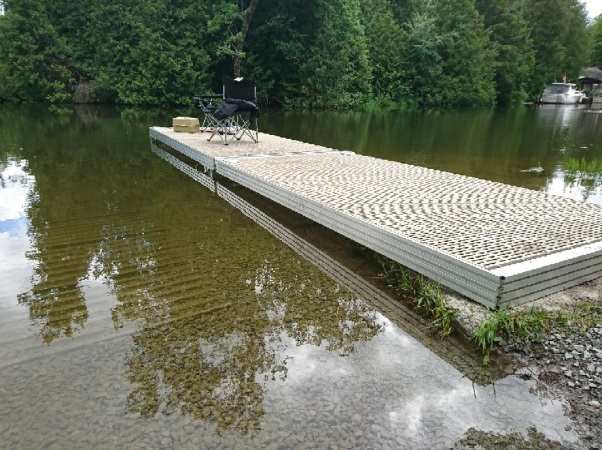
Figure 7: Installed mooring dock.
To improve access to Lake Simcoe for anglers and boaters, the project also replaced the old unsafe launch pad and installed a mooring dock (Figure 7).
Stewardship
In the Lake Simcoe watershed, all sectors of the community are responsible for environmental impacts and collectively share the responsibility of protecting the lake. Stewardship, education, and outreach activities help us better understand cumulative influences on the watershed and encourage local businesses, government, community groups and residents to take action to ensure lasting positive change in the Lake Simcoe watershed.
Youth Rangers Stewardship
Lake Simcoe had a dedicated Ranger team through the Stewardship Youth Ranger program in the summer of 2017. The program provided opportunities for rangers to get hands-on experience, education and training in natural resource management. The rangers completed a number of projects with a variety of partners within the Lake Simcoe watershed, including trail maintenance, invasive species removal, boardwalk construction, seine net monitoring, shoreline clean-up, and assisting at a Family Fishing event.
Aquatic Life
Aquatic life in the tributaries and the lake is an important indicator of ecosystem health. Lake Simcoe is a popular fishing destination for its Lake Trout, Lake Whitefish, Yellow Perch and Smallmouth Bass fisheries and draws an estimated one million angler hours per year. Changing lake conditions, due to natural and human impacts, have had significant implications for the Lake Simcoe fisheries and the socio-economic benefits from recreational fishing.
Aquatic Monitoring Program
Since the early 1950s, the Ministry of Natural Resources and Forestry has studied Lake Simcoe aquatic fish communities and the recreational fisheries through the Lake Simcoe Fisheries Assessment Unit’s Aquatic Monitoring Program. This monitoring provides important information on lake health and ecosystem trends that measure the plan’s progress and provides essential information to manage this important fishery. For example, the winter and summer Angler Surveys have been carried out regularly since 1957 and 1961. These surveys measure fishing effort, catch and harvest of fish during the winter ice fishing season and the summer open water season. This data improves our understanding of the social and economic value of the fishery. It also supports fisheries’ management decisions and to provide information on fish population trends that inform the ecological health of the lake.
Examples of the information gathered through monitoring are:
- natural reproduction of nearshore and offshore native aquatic communities
- warmwater and coldwater fish community composition (similar work on the warm and cold water fish communities in the tributaries is conducted annually by Lake Simcoe Region Conservation Authority)
- diet studies of warmwater and coldwater fish species
- fall egg collections for Lake Trout and Lake Whitefish in support of cold water fish community rehabilitative stocking efforts
- fishing effort and fish harvest during the winter and open-water angling seasons.
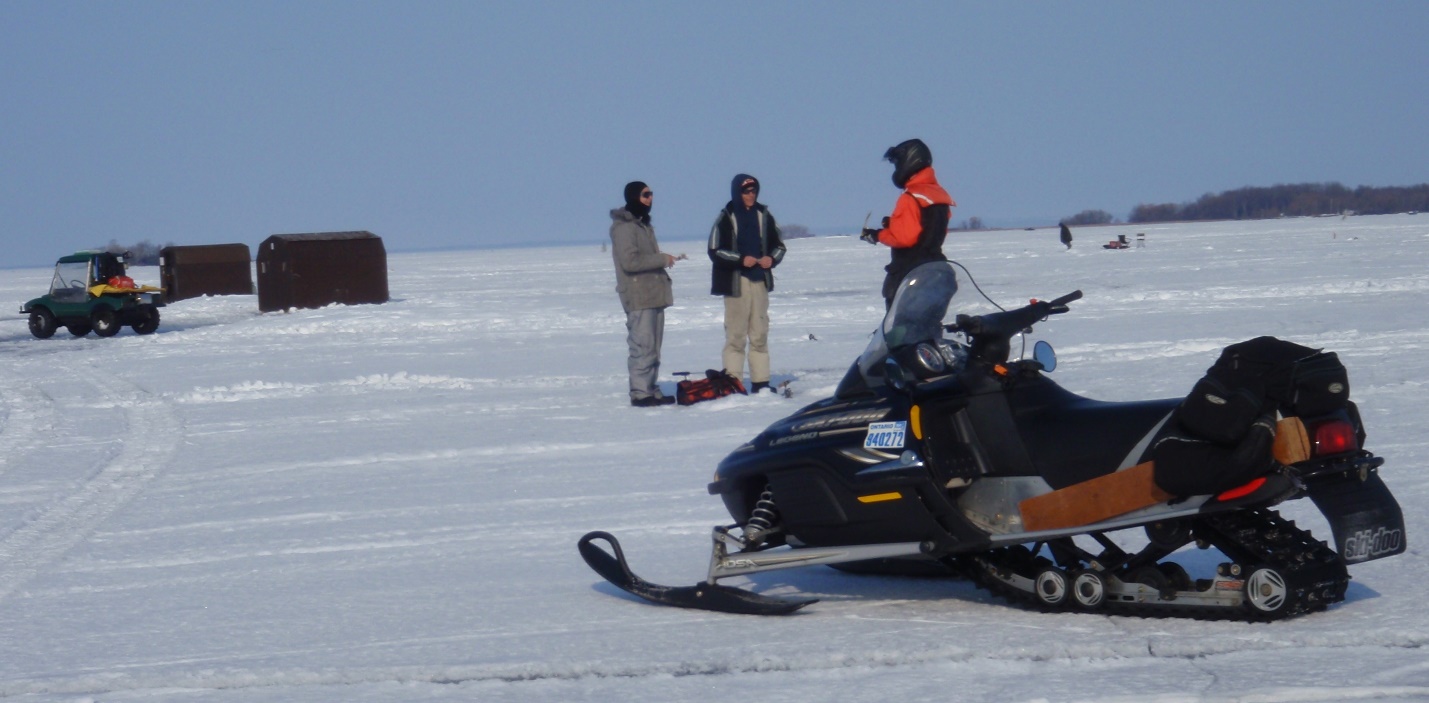
Figure 8: Ministry staff interviewing anglers as part of a creel survey on Lake Simcoe.
Coldwater Fish Status Review
A primary indicator used to assess ecological health in Lake Simcoe is the status of coldwater fish, due to their sensitivity to water quality changes. The Southern Biodiversity and Monitoring Section and Lake Simcoe Fisheries Assessment Unit have undertaken a variety of netting and angler surveys to monitor Lake Simcoe’s coldwater fish species.
A review of the status of coldwater fish was completed by the Ministry of Natural Resources and Forestry. This review compiles data on Lake Trout, Lake Whitefish, Cisco and Burbot to provide insight on the status of the coldwater fish community of Lake Simcoe and to summarize critical information to enhance and guide future management efforts. Detailed results from the review can be found in the The Status of Coldwater Fishes of Lake Simcoe report available through the Ministry of Natural Resource and Forestry’s Science and Research Branch publication series.
Fish community research to support sustainable fisheries
Researchers in the Ministry of Natural Resources and Forestry’s Aquatic Research and Monitoring Section are conducting multiple projects to inform management of valuable fish populations on Lake Simcoe. In 2017 fisheries sonar surveys were conducted for the seventh consecutive year to assess the open-water fish community of Lake Simcoe. The survey showed continuous signs of recovery in the Cisco population, a native prey for Lake Trout, which was once in steep decline in the lake. The improving population status has allowed for a conservative winter fishery to be re-opened since 2015.
To understand trends in the numbers of Cisco and other important sportfish such as Lake Whitefish, Lake Trout, and Yellow Perch, since 2015 researchers have collected newly hatched (larval) fish (depicted in Figure 9) in the spring at the same time as sampling zooplankton, the food that is available at this critical life stage. An additional focus in 2017 was assessing the diet and growth of larval fish. Trends in larval fish numbers, and their diet and growth, help show why in certain years many more fish are born and survive than in other years and how climate change and invasive species might affect these patterns. This information will help the management of sustainable fisheries on Lake Simcoe.

Figure 9: A larval Cisco collected from Lake Simcoe in the spring of 2017. This fish is approximately 9 millimeters long. DNA barcoding conducted at the Ministry of Natural Resource and Forestry’s Aquatic Research and Monitoring Section genetic laboratory is used to identify the species of fish.
Microplastics in fish
Plastic particles that are less than five millimeters in diameter are referred to as microplastics. Microplastics in water are increasingly a topic of concern because they can be mistaken for food and ingested by insects, plankton, fish, and other aquatic life. Microplastics may pose a threat to entire ecosystems. The University of Toronto is completing research to determine the quantity and types of microplastics in sport fish sampled from Lake Simcoe and Lake Ontario. Fish sampled as part of this study include Pike, Lake Trout, Lake Whitefish, Yellow Perch, Bass and Walleye.
Researchers are also determining what chemical contaminants are associated with microplastics in Lake Simcoe and if there is any evidence of microplastics or associated chemical contaminants in the fish fillets that are consumed by humans.
Researchers will combine data from this research with that of other studies to help determine if there are risks (i.e., nutritional value or food safety) associated with eating fish from the Lake Simcoe watershed area.
Invasive species
The presence and spread of invasive species in an ecosystem is a way of knowing how healthy the ecosystem is. The effects of invasive species on the aquatic and terrestrial ecosystems of the Lake Simcoe watershed can have significant ecological and economic consequences, including lost revenue from tourism and recreation, increased costs of managing them and damage to infrastructure. Monitoring and research play an important role in improving our knowledge of invasive species, which can then be incorporated into early detection, rapid response and management strategies.
Water Soldier
The Ministry of Natural Resources and Forestry continues its effort to eradicate the invasive plant, Water Soldier, from the Black River of Lake Simcoe where populations of the plant were identified. This is the only known invasion of Water Soldier in the Lake Simcoe watershed, and only the second known introduction in inland waters in North America. The ministry and partners will continue monitoring and control efforts, and deliver education and outreach initiatives with the intent of eradicating this species from the Simcoe watershed and preventing its future re-introduction. Read more here about how partners are trying to eradicate Water Soldier.
Operation Bait Bucket Program

Figure 10: Logo for Operation Bait Bucket.
The Operation Bait Bucket program was carried out by the Ontario Federation of Anglers and Hunters with support from the Ministry of Natural Resources and Forestry to engages ice anglers about the importance of maintaining the health of Lake Simcoe by stopping the spread of invasive species and diseases such as Viral Hemorrhagic Septicemia. Operation Bait Bucket crews connected with anglers at shore access points, fishing derbies and festivals, and trade shows. A media campaign was developed and anglers and the public were educated through radio commercials. Nearly 3,000 anglers were reached through the program. Anglers are encouraged to buy locally produced bait and to never dump leftover baitfish or bait bucket contents onto the ice or into the lake.
Clean, Drain, Dry Boater Education and Outreach
The Ontario Federation of Anglers and Hunters delivered the Clean, Drain, Dry message to boaters and anglers throughout the summer at fishing tournaments, provincial parks, garden centers, marinas and locks. A portable boat wash unit was taken to various sites where it was used to clean boat trailers and boats. The team was able to wash approximately 170 watercrafts and deliver invasive species messaging to approximately 650 people during visits to six fishing tournaments, five provincial parks, fifteen garden centres, eight marinas, seven lock stations on the Trent-Severn Waterway and five community events.
Outreach crews showed anglers how they can remove aquatic plant hitchhikers to prevent the spread of unwanted invasive species to other waterbodies. The campaign encouraged anglers to become ambassadors and share the message at tournaments throughout the province.
Agriculture
The Lake Simcoe watershed contains some of the most productive agricultural land in Ontario, including the Holland Marsh. These lands generate over $450 million annually and are also close to large urban markets. Innovative agricultural practices and technologies, such as buffer strips along streams and rivers, cover crops and low-impact cropping and fertilizing methods, can help improve the health of the lake and its watershed. Projects undertaken reflect the diversity of agricultural production and food processing in the Lake Simcoe watershed, and align with key aspects of the Lake Simcoe vision, including healthy environment, socially responsible economic benefits in the region, and building leadership in partners who protect the lake.
Holland Marsh Sustainability Strategy
The Holland Marsh is a well-known specialty crop production area on the south end of Lake Simcoe, known for its unique and highly productive muck soils. To support the long-term sustainability and productive capacity of this unique agricultural region, the Ministry of Agriculture, Food and Rural Affairs partnered with the Holland Marsh Growers Association (HMGA) to explore sustainability challenges facing farmers and food processors who live and work in the Marsh. The goal of the strategy was to develop a series of recommendations and associated actions as the basis of a ten-year blueprint using the three pillars of sustainability (social, economic and environmental). The strategy was finalized using interviews with Marsh farmers, the Muck Crops Research Station staff, and soil and crop specialists, and in consultation with the association’s Board of Directors. Some examples of the types of recommendations provided in the Strategy include: exploring enhanced marketing, branding and value-added opportunities for Marsh products; supporting leadership and organizational capacity within the Holland Marsh Growers Association; expanding the scope of the Muck Crops Research Station to include sustainable farming practices; and developing further muck soil specific best management practice extension materials. The partners in the strategy will be working on implementing the actions over the next ten years
Water Smart Farming
To raise awareness and encourage the adoption of the best available water optimization technology for agricultural operations in the Lake Simcoe watershed, Farm and Food Care Ontario conducted a two-year Water Smart Farming Project. The goal of the project was to identify opportunities to optimize water use through reduction, reuse and recycling at each site and lower costs for producers along with making water treatment systems smaller and more economical to operate and manage. Individual farmers and farm managers were consulted to raise awareness, conduct assessments and share new best management practices on water efficiency.
The project offered several options for farm managers to address improvements in water use efficiency:
- Before and after on-farm water use assessments, including irrigation use efficiency
- Water monitoring information hardware (rotameters, soil moisture probes, water meters)
- Greenhouse stormwater pond assessments and characterization
An important outcome of the project was to promote efficient water use among growers in the Lake Simcoe watershed and facilitate sharing advice about equipment, technologies and techniques related to water use reducing, reusing and recycling.
Review of Agri-environmental Stewardship Programming Projects
The Ontario Soil and Crop Improvement Association conducted a retrospective analysis of stewardship projects in the watershed from 2004 to 2017. The study found that Lake Simcoe farmers have made significant effort to address environmental concerns in the watershed. For example, since 2004, 1,248 projects have been implemented in the Lake Simcoe watershed by approximately 376 individual farm businesses (22 per cent of total farms in the watershed), with approximately $15.7 million invested by participating Lake Simcoe farms over the 13 year period. Over the same 13-year period, farmers planted approximately 16,000 trees, installed about 23 kilometres of livestock exclusion fencing along streams, and applied farm planning activities (water and nutrient plans) to benefit an estimated 25,000 acres of cropland.
Although significant stewardship outcomes were achieved through projects on farms in the watershed, the analysis also identified a declining trend over time of farmer participation in stewardship programs. The report offers many possible reasons for the decline. The findings can assist in reassessing stewardship program approaches and inform adaptive management to ensure future education and cost-share programs are better tailored to the specific needs of farmers in the Lake Simcoe watershed.
Greenhouse and Nursery Wastewater Reuse
The horticultural industry is under constant pressure to improve environmental performance while remaining competitive. From a growers’ perspective, water quality and quantity (i.e. good quality, consistent supply) are key factors in the operation’s ability to produce high quality plants and products. Growers with poor water quality sources, farms that seek to reduce nutrient loss, or farms that are trying to maximize their water use efficiency by recycling their operational water, are looking for cost-effective systems to treat their water. The treatment systems also should be customizable to meet their specific needs, while requiring minimal maintenance.
With these challenges in mind, Flowers Canada (Ontario) Inc. collaborated with both Agriculture and Agri-Food Canada and the Ministry of Agriculture, Food and Rural Affairs, to design and test innovative technologies for greenhouse and nursery farmers to manage their operational water. More specifically, project staff designed and tested combination systems such as woodchip denitrification bioreactors, selective mineral media and a constructed wetland design – a truly “Hybrid Treatment System” concept. The ultimate goal of the project was to develop custom greenhouse and nursery wastewater treatment systems that protect the environment and enable growers to recover and reuse wastewater to improve water and nutrient use efficiency without risking crop health. Project staff also developed a detailed guidance document for growers to aid in selecting and designing site-specific water treatment technologies.

Figure 11: Schematic of a permanent Hybrid Treatment System (HTS) at a greenhouse site
Best Management Practices in the Talbot Watershed (City of Kawartha Lakes)
The agricultural sector contributes significantly to the economy and quality of life in the City of Kawartha Lakes. It is estimated that primary agriculture in the City of Kawartha Lakes and the Greater Peterborough area contributes in excess of $353 million annually to the area economy (Kawartha Lakes Agricultural Action Plan 2010).
Recognizing the importance of a sustainable agri-food sector for the region, Kawartha Conservation launched the Kawartha Lakes Farmland Stewardship Fund, in partnership with the Ministry of Agriculture, Food and Rural Affairs in 2014. This fund has provided support to landowners for projects to minimize nutrient and sediment input to waterbodies within the City of Kawartha Lakes, including the Talbot River watershed. Landowners completed more than 30 farmland stewardship projects implementing best management practices to reduce phosphorus load, and manage riparian soil and water. Specific projects include improving runoff from livestock yards or manure storage, fencing and alternative watering adjacent to water courses, riparian buffer and grassed waterway creation, and planting of windbreaks and shelterbelts. These agricultural improvements will help to minimize soil erosion and support nutrient loss reduction within the Talbot River (a major Lake Simcoe tributary) including the watersheds of Canal and Mitchell Lakes.
Watch videos about some of the important projects in the Talbot Watershed:
- Eavestrough and Barnyard Improvement
- Live Stock Exclusion Project
- Well Stewardship Farm
- Planting Trees
- Lake Management Planning and Stewardship
Climate change
As the Earth’s climate warms, changing patterns of temperature, precipitation and wind are expected to impact the ecological health and all aspects of life for many communities in the watershed. A range of partners are implementing actions to build resilience and increase local capacity to adapt throughout the watershed.
Stormwater Management Pond Climate Risk Assessments
Stormwater management mitigates the consequences of urbanization on the hydrologic cycle, including increased runoff and decreased infiltration of rain and snowmelt. Without proper stormwater management, poor water quality, low water flow after precipitation events, flooding and erosion can lead to reduced diversity of aquatic life, fewer opportunities for human uses of water resources, and the potential for loss of property and human life.
The Lake Simcoe Protection Plan requires a combination of site level, conveyance, and end-of-pipe stormwater management practices to meet multiple objectives including: maintaining the hydrologic cycle; protection of water quality; and preventing increased erosion and flooding.
Historically, stormwater management ponds have been used as a popular best management practice across the watershed. The performance of a stormwater management pond is influenced by a number of factors. The Lake Simcoe Region Conservation Authority assessed a number of stormwater ponds of different ages as well as catchment land use types to develop a better understanding of how ponds function as they age to serve as a forecast for how they are expected to function in the future with a changing climate.
Some of the key findings are:
- regular inspection and maintenance is important to ensure optimal pond function;
- pond sedimentation rates vary and it is difficult to estimate the appropriate clean-out frequency;
- winter salt use is causing persistent stratification in many ponds;
- stratification is resulting in poor dissolved oxygen levels and re-release of nutrients from sediments; and
- invasive goldfish play a role in persistent pond turbidity
Developing a better understanding of pond function and stressors will help optimize stormwater infrastructure and mitigate the impacts of urban stormwater runoff.
Recreation
For generations, water and trail related activities have connected people to the ecosystems of the Lake Simcoe watershed. The Lake Simcoe watershed provides diverse recreational opportunities, from ice-fishing and snowmobiling in the winter to boating, fishing and hiking in the summer. These nature-based recreational activities attract thousands of residents and visitors. Research and monitoring are helping to manage recreational activities that have the potential to impact water quality, water quantity, aquatic life and the spread of invasive species so that people can continue to enjoy all that Lake Simcoe has to offer.
Green Festival Mobilization
To manage events in a socially and environmentally responsible way, Ryerson University‘s Ted Rogers Institute for Tourism and Hospitality Research completed a study to examine the level of sustainability across Canadian festivals. The research found that approximately 10 per cent of the 303 festivals held in 2016 promoted six or more sustainable practices to their attendees.
Mariposa Folk Festival, (Orillia, Ontario) is a leader in festival ‘greening’ initiatives. The Tourism Industry Association of Ontario awarded Mariposa the Award of Excellence for Sustainable Tourism because of their greening initiatives that began in 2009 with the support of Ryerson University. In 2015, they had an 88 per cent landfill diversion rate. Festival organizers can make their events more sustainable by using the Greening Topics checklists.
Sustainable Tourism
The Explore Lake Simcoe program was created by Tourism Barrie in response to research that showed business operators are willing to implement sustainable tourism practices if they have access to resources. The program provided small business tourism operators in the Lake Simcoe watershed with free individualized guidance, information, and resources around environmentally-sustainable practices. Businesses that used or applied new sustainable practices were highlighted on the Explore Lake Simcoe website.
Over the duration of the project, the Explore Lake Simcoe program advertised to over 85,000 potential participants, reached out to 390 businesses, and met with 117 business owners. Newly-adopted practices relate to waste management/diversion, transportation, eco-friendly cleaning supplies, purchasing, energy efficiency, water conservation and protection, employee engagement or customer education. An example of one of the initiatives implemented was the #nostrawchallenge, which saw 10 food service establishments in Downtown Barrie divert 18,000 straws from landfill over the course of six weeks.
The Green Leaders profiled in the project were eager to share information and ideas between businesses interested in implementing sustainable practices to their operations. Businesses that are committed to environmental sustainability have been open to learn from their peers and adopt successful best practices.
Greening Golf Courses
Lake Simcoe watershed is home to more than 50 golf courses. According to Golf Week magazine, “typical urban golf courses are about 110 to 120 acres.” Given their size, the practices of these businesses can have a significant impact on the natural environment.
During the golf season of 2017, Explore Lake Simcoe enlisted the participation of 17 golf course owners/operators in the Lake Simcoe watershed to share their best management practices and to help find new ways to distribute ideas and information about reducing environmental impacts by adopting best practices.
In 2017, Tourism Barrie, a stakeholder in Explore Lake Simcoe, awarded Pheasant Run Golf Course a Green Golf Project participant award for environmental sustainability. This award recognizes a tourism industry business/organization that has reduced their environmental impact by adopting greening practices and promoting sustainable tourism.

Figure 12: Staff from Pheasant Run Golf Course receiving the Environmental Sustainability award from Tourism Barrie.
Appendix
Advice from the Minister’s Advisory Committees
Two publicly appointed committees were established in 2010 under the Lake Simcoe Protection Act – the Lake Simcoe Coordinating Committee and the Lake Simcoe Science Committee. These committees provide advice to the Minister of the Environment, Conservation and Parks on the implementation of the Lake Simcoe Protection Plan and the ecological health of the Lake Simcoe watershed.
In addition to regular advice provided to provincial staff during committee meetings, the committees submitted four joint priority recommendations to the minister for 2017. Advice provided by the committee informs the adaptive management process and focused on four key areas:
- To develop and implement a plan to achieve natural cover and natural shoreline targets, and to analyze progress in these areas in order to determine whether, and how, the LSPP could be modified to better achieve those targets. To this end, we recommend the province undertake a science-based shoreline management strategy which defines policy on what can be done, and where, on the shoreline.
- To promote partnership with First Nations in implementing the LSPP, fund a position under the direction of Lake Simcoe’s First Nations, to prioritize LSPP policies that require more thorough First Nations involvement, input, and/or Traditional Ecological Knowledge.
- To ensure that high priority phosphorus reduction projects obtain the funds needed to proceed, reconsider the Phosphorus Reduction Strategy’s proportional reduction framework as it currently limits the ability to make cost-effective phosphorus reductions.
- Climate change is a significant stressor which will negatively impact watershed health. More detailed Climate Change Adaptation and Mitigation Plans are needed. At a minimum these Plans need to inform policy, remedial control options and education and engagement programs. A risk management and cost benefit approach should be employed to set priorities for action and all activities should have associated performance measures to document progress. Areas where we expect the greatest consequences are:
- lake and river water temperature regimes,
- lake water quality,
- impacts on native species and recreational fisheries,
- risks of new invasive species, and
- natural heritage, such as changes in forest succession.
The province continues to take strong action to protect and restore the ecological health of Lake Simcoe and its watershed and would like to thank all committee members for their commitment to Lake Simcoe and for providing their best advice.